The Dental Suction Systems Market is estimated to be valued at USD 462.6 million in 2025 and is projected to reach USD 1542.7 million by 2035, registering a compound annual growth rate (CAGR) of 12.8% over the forecast period.
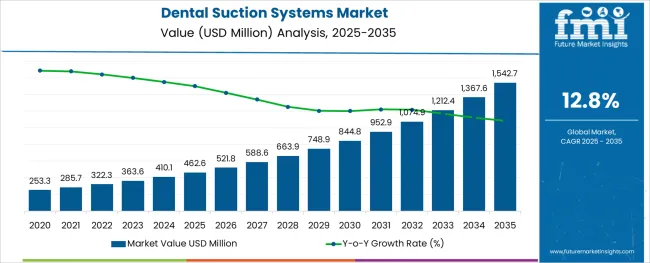
The dental suction systems market is progressing steadily as advancements in dental care infrastructure, rising awareness about infection control, and increasing procedural volumes drive adoption of efficient suction technologies.
The demand for effective aerosol and debris removal during procedures has intensified with heightened emphasis on patient and practitioner safety. Developments in quieter, energy-efficient, and space-saving systems are further enhancing their appeal among practitioners aiming to modernize clinics.
Future growth is expected to be supported by regulatory focus on hygiene standards, integration of advanced filtration mechanisms, and a shift toward environmentally sustainable systems. Expanding dental care access and consolidation of dental practices are paving the way for wider adoption and innovations in suction technologies, aligning operational needs with emerging health and environmental considerations.
The market is segmented by Product Type and End-use and region. By Product Type, the market is divided into Wet Suction and Dry Suction. In terms of End-use, the market is classified into Dental Offices and Hospitals. Regionally, the market is classified into North America, Latin America, Western Europe, Eastern Europe, Balkan & Baltic Countries, Russia & Belarus, Central Asia, East Asia, South Asia & Pacific, and the Middle East & Africa.
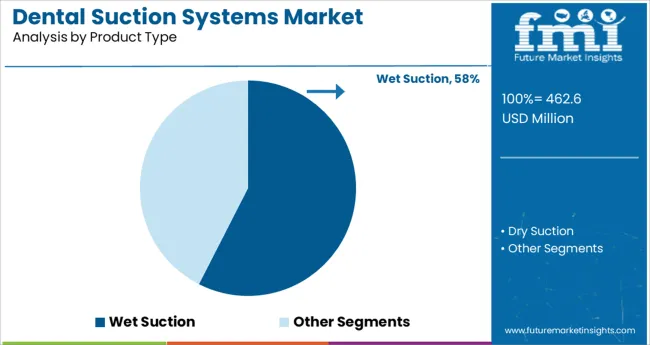
When segmented by product type, wet suction is anticipated to hold 57.5% of the total market revenue in 2025, establishing it as the leading product segment. This dominance has been attributed to the superior operational efficiency and quieter performance of wet systems, which have been preferred in high-volume practices requiring consistent suction power.
The ability to handle larger patient loads without significant wear or loss of suction has strengthened its positioning among practitioners seeking reliability and durability.
Wet suction systems have also been favored for their lower maintenance needs compared to dry alternatives and their capacity to manage both liquids and solids effectively, enhancing procedure outcomes. Improvements in water management and energy efficiency have further reinforced their adoption as the solution of choice in modern dental settings prioritizing both performance and patient comfort.
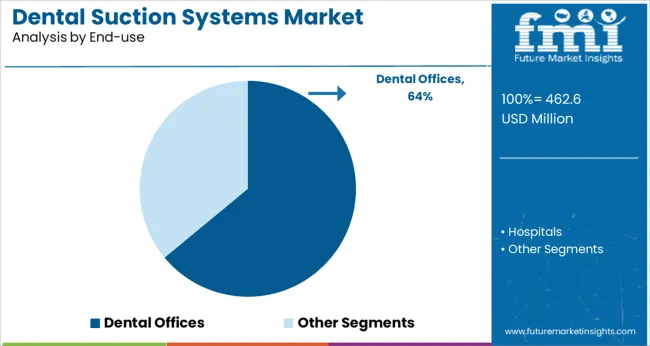
Segmented by end use, dental offices are projected to command 64.0% of the market revenue in 2025, sustaining their leadership position. This predominance has been shaped by the central role of dental offices in delivering primary oral healthcare services, where the need for effective, hygienic, and compact suction systems remains critical.
The widespread presence of independent and group dental practices has enabled faster adoption of advanced suction solutions tailored to smaller but high-frequency clinical environments. Dental offices have increasingly prioritized patient experience, procedural efficiency, and regulatory compliance, which has supported investments in modern, noise-reduced, and space-efficient suction technologies.
The ability to integrate seamlessly into existing office layouts and the flexibility to scale with growing patient volumes have further consolidated dental offices’ share, positioning them as the foremost contributors to the market’s growth trajectory.
The global market for dental suction systems registered a CAGR of 10.3% over the last five years (2020 to 2024). The increased number of dental procedures performed all over the world is driving the dental suction system market.
In 2024, the global market size of the dental suction system was valued at USD 462.6 million and is expected to increase to a valuation of USD 322.3 million in 2025. A dental suction system is used to suck saliva, blood, and other particles from the mouth during a dental procedure. Dental suction units ensure the patient’s safety by sucking the debris properly from the mouth otherwise it can go to the patient’s lungs or throat and thereby lead to choking the patient and putting them at risk.
The technologies not only increase hygiene but also process efficiency and dental professional comfort. During a critical dental emergency, the correct suction pump decreases the risk of complications, improves patient outcomes, and gives a clear field vision. As a result, the system's benefits, relevance, and features are expected to drive demand, consequently boosting market expansion.
The global dental suction system market is predicted to surge ahead at a CAGR of 12.8% and record sales worth USD 1542.7 billion by the end of 2035. The USA will continue to be the largest user of the dental suction system throughout the analysis period accounting for over USD 251.2 million absolute dollar opportunity in the coming 10-year epoch.
Cosmetic dentistry has gained significant momentum over the years. Cosmetic dentistry focuses on enhancing the appearance and meeting the needs of the clients. The primary focus on perfect looks has led to smile makeovers, which is rising the demand for cosmetic dentistry. The changing lifestyle and concepts about perfect looks are promoting youth to cosmetic dentistry, and consequently dental suction.
The dental healthcare sector is witnessing rapid technological advancement over the years. Extraoral suction units were an effective method to minimize droplet spatter during the operative dental procedure. The extraoral suction unit contains a HEPA filter that captures viruses and contaminations within the aerosols and filters thereby preventing cross-infection between patients and doctors.
This new suction system has currently been adopted by many clinics to increase patient visits to their clinics. In 2024, pH Dental Inc launched its PAX2000 suction system including with five-stage filtering system. The system's outer layers of carbon and pre-filtration of HEPA, ultraviolet rays, and plasma, as well as a VOC filter, comprise the four layers of the system. The availability of such cutting-edge technologies is likely to boost product demand, boosting market expansion.
The lack of knowledge and awareness about oral health care is leading to a lack of voluntary visits among the people. In addition, people around the world have dental anxiety, which is also reducing the number of visits to dental offices and hospital settings. These factors are expected to restrain the growth of the dental suction systems market.
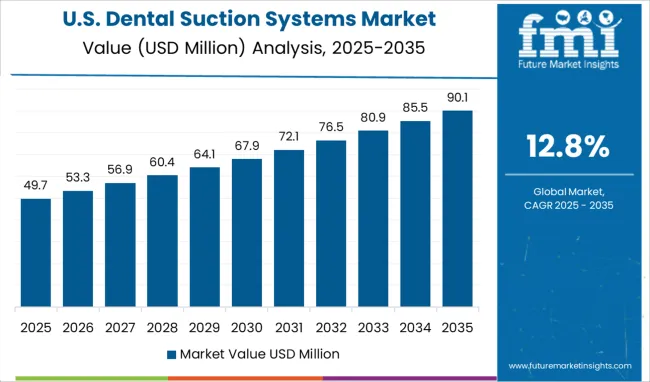
The increased awareness of oral hygiene and improved healthcare facilities and rapid adoption of new technologies are driving the market in the region. The increasing number of dental offices and hospitals is also boosting the adoption of the dental suction system in the region. In addition, North America is home to some prominent players in the market, which also boost the market growth in this region.

According to a survey conducted by the American Academy of Cosmetic Dentistry in 2020, the demand for cosmetic procedures is increasing in the USA In addition, rising oral diseases among the USA population are boosting the visits of patients to dental offices, which is driving the market of dental suction systems in the USA. The USA market is forecasted to grow at a CAGR of 12.8% from 2025 to 2035.
The high prevalence of oral diseases among the Chinese population has motivated the government to formulate policies to strengthen the oral healthcare infrastructure in China. The policy for pacing up the development of oral health-related industries to meet the patient population demand is expected to drive the dental suction systems market in China. The dental suction system market in China is forecasted to reach a valuation of USD 1542.7 million by 2035.
The market in the United Kingdom is projected to surge to USD 51.3 million by 2035, growing at a CAGR of 13.1% from 2025 to 2035. The market in the country is expected to gross an absolute dollar opportunity of USD 36 million during the forecast period.
In Japan, the market is projected to expand at a CAGR of 16.7% from 2025 to 2035 to reach a valuation of USD 571 million by 2035. The market in the country is expected to garner an absolute dollar opportunity of around USD 45 million.
Wet suction units use water to create a vacuum and suck the debris from the mouth using the aspirator tube. The key advantage of wet suction units is that they feature a reverse flow valve, which prevents backflow and avoids possible contamination. The wet suction segment accounted for a CAGR of 10.7% from 2020 to 2024.
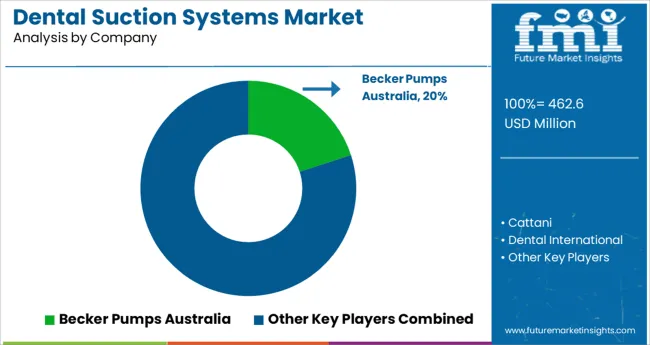
The key companies operating in the dental suction system market include Becker Pumps Australia, Cattani, Dental International, Metasys Dental, Eschmann, Ads Dental System, Ko-max Co., Ltd., A-dec, Dentsply Sirona, DentalEZ, Inc., DÜRR DENTAL, Vacutronics, Inc., Simple & Smart Dental Units, W&H Dentalwerk, Unimicro Medical Systems, KUGEL Medical, Henry Schein Dental, pH Dental Inc, Air Techniques, Inc.,
Some of the recent developments by key providers of Dental Suction Systems are as follows:
Similarly, recent developments related to companies manufacturing dental suction systems have been tracked by the team at Future Market Insights, which is available in the full report.
The global dental suction systems market is estimated to be valued at USD 462.6 million in 2025.
It is projected to reach USD 1,542.7 million by 2035.
The market is expected to grow at a 12.8% CAGR between 2025 and 2035.
The key product types are wet suction and dry suction.
dental offices segment is expected to dominate with a 64.0% industry share in 2025.






Full Research Suite comprises of:
Market outlook & trends analysis
Interviews & case studies
Strategic recommendations
Vendor profiles & capabilities analysis
5-year forecasts
8 regions and 60+ country-level data splits
Market segment data splits
12 months of continuous data updates
DELIVERED AS:
PDF EXCEL ONLINE
Dental Implant and Prosthetic Market Size and Share Forecast Outlook 2025 to 2035
Dental Imaging Equipment Market Forecast and Outlook 2025 to 2035
Dental Wounds Treatment Market Size and Share Forecast Outlook 2025 to 2035
Dental Radiometer Market Size and Share Forecast Outlook 2025 to 2035
Dental Anaesthetic Market Size and Share Forecast Outlook 2025 to 2035
Dental Diamond Bur Market Size and Share Forecast Outlook 2025 to 2035
Dental Laboratory Market Size and Share Forecast Outlook 2025 to 2035
Dental Permanent Cements Market Size and Share Forecast Outlook 2025 to 2035
Dental Bleaching Agent Market Size and Share Forecast Outlook 2025 to 2035
Dental Care Products Market Size and Share Forecast Outlook 2025 to 2035
Dental Etching Liquid Market Size and Share Forecast Outlook 2025 to 2035
Dental Sutures Market Analysis - Size, Share, and Forecast Outlook 2025 to 2035
Dental Hygiene Devices Market Size and Share Forecast Outlook 2025 to 2035
Dental Implantology Software Market Analysis - Size, Growth, & Forecast Outlook 2025 to 2035
Dental Veneers Market Size and Share Forecast Outlook 2025 to 2035
Dental Articulators Market Size and Share Forecast Outlook 2025 to 2035
Dental Fluoride Varnish Market Size and Share Forecast Outlook 2025 to 2035
Dental Adhesives Market Size and Share Forecast Outlook 2025 to 2035
Dental Flap Surgery Market Size and Share Forecast Outlook 2025 to 2035
Dental Chairs Market Size and Share Forecast Outlook 2025 to 2035

Thank you!
You will receive an email from our Business Development Manager. Please be sure to check your SPAM/JUNK folder too.
Chat With
MaRIA